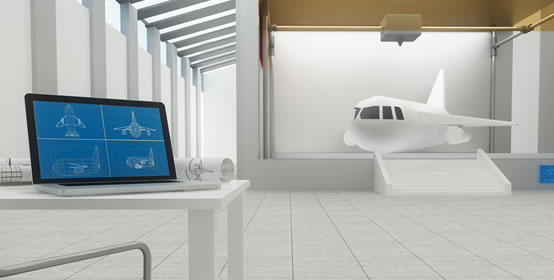
From bicycle tires and biodegradable fashion to the world's first 3D-printed car, the list of products created through additive manufacturing is rapidly expanding. Nowhere is that growth more evident than in the aerospace industry. Companies like Boeing and Lockheed Martin are already using 3D printers to fabricate parts and tools. Space start-ups funded by deep-pocket investors have their sights set on the stars as well. If the upward trajectory of additive manufacturing is any indication, it won't be long before 3D-printed rockets launch into space.
Cost control is the mega-trend driving the development of 3D printing in the aerospace industry. In traditional manufacturing, creating new designs and parts is a laborious process involving shaping materials with specialized lathes, presses or molds. Aerospace companies must often make huge investments in equipment for short runs of parts. The flexibility of 3D printing allows manufacturers to produce any number of parts without making costly tooling changes.
Most 3D companies focus on printing small-scale components for their aeronautical clients. Considering the potential cost savings, large aerospace companies have found it more profitable to contract out the work. Lockheed Martin's F-35 fight aircraft, for example, has around 4,000 tools made by 3D companies like Stratasys. More than 100 parts on NASA's Orion spacecraft were printed by aluminum specialist Arconic. Today, small-part suppliers simply can't compete without 3D printing capabilities.
Thanks to recent increases in the US defense budget, the aerospace space industry is making larger investments in 3D equipment and technology. Boeing is providing funding to 3D companies to enhance the development of metal-based additive engineering for titanium and aluminum alloys. Lockheed Martin is making substantial investments in 3D technology to produce everything from production fixtures to vehicles for ground, underwater and space exploration.
Private investors are pouring money into aerospace 3D technology too. Whether they're interested in launching rockets or people, billionaires from Richard Branson to Elon Musk and Jeff Bezos are leading the charge by providing funds for commercial space companies.
With funding from Mark Cuban, a new company call Relativity is hoping to develop the first 3D-printed rocket. Scheduled to launch in 2020, the “Terran 1” could reduce the time it takes to build a rocket from 12 to 18 months to just 60 days.
The ability to print components that can withstand the stress of launching into space is critical to the advancement of aerospace 3D technology. Some of the most exciting developments come from the Lawrence Livermore National Laboratory in California where printers are being used to control metal fabrication on a microscopic level. These innovations make it possible to create steel and aluminum alloys that are up to three times stronger than previous 3D metals.
Printers that overcome size limitations are making headlines too. GE recently introduced a beta version of its new 3D printer, which can print metal parts as large as one meter in diameter. The company's new jet engine combustion liner is produced as a single piece using this groundbreaking printer.
Technologies that allow printers to detect and repair flaws during the printing process are also under development. Some innovators are even incorporating artificial intelligence into printer design so that the machines can “learn” to avoid producing flaws.
With 3D printed drones already flying the skies and 3D rockets under development, can 3D spacecraft be far behind? Lockheed Martin's Michael D. Packer calls structures printed entirely with additive manufacturing the “holy grail.” The Director of Manufacturing, Advanced Production Programs adds that increasing the scale of 3D printers while improving high deposition rates is the key to reaching that far-reaching goal.
Tim Ellis, the co-founder of the start-up Relativity, is far more optimistic. The rocket company has already built a 24-foot-tall printer and plans are underway to construct an even larger one soon. Equipped with robotic arms, it will 3D print around 95 percent of the company's satellite-bearing rockets.
With funding on the rise, technologies developing at a rapid pace and plans for large on-site printers underway, it's only a matter of time before 3D printed spacecraft take to the skies. It's not out of this world to predict that 3D printing will be a driving force behind the future of space exploration.